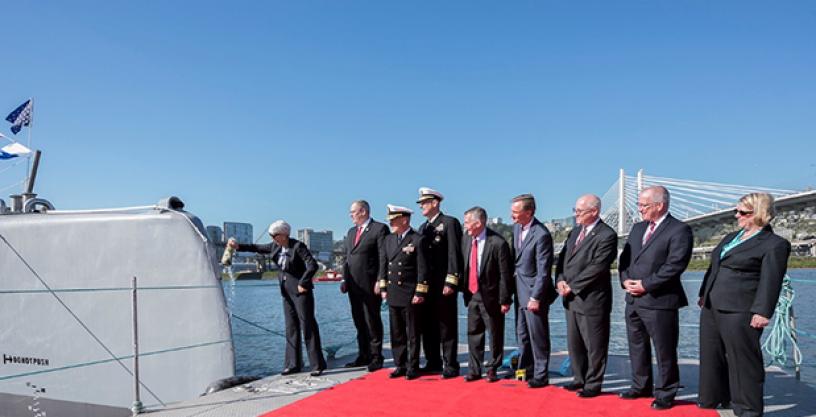
Agency and Defense Department celebrate progress toward developing a highly autonomous unmanned ship that could revolutionize U.S. maritime operations
Apr 11, 2016
“It’s my privilege and honor to christen thee Sea Hunter!” DARPA Director Arati Prabhakar proclaimed, capping the christening ceremony last week for the technology demonstration vessel developed and built through the Agency’s Anti-Submarine Warfare (ASW) Continuous Trail Unmanned Vessel (ACTUV) program. She then broke a ceremonial “champagne” bottle (the contents were non-alcoholic) against the bow of the prototype ship, in front of approximately 100 guests, including Deputy Secretary of Defense Robert Work and senior U.S. Navy and government officials.
Taking place in Portland, Oregon, the event marked the vessel’s formal transition from a DARPA-led design and construction project to a new stage of open-water testing to be conducted jointly with the Office of Naval Research (ONR). The christening signified the beginnings of an entirely new class of ocean-going vessel—one able to traverse thousands of kilometers over the open seas for month at a time, without a single crew member aboard. Potential missions include submarine tracking and countermine activities.
In September 2014, DARPA signed a Memorandum of Agreement (MOA) with the Office of Naval Research to jointly fund an extended test phase of an ACTUV prototype. DARPA will collaborate with ONR to fully test the capabilities of the vessel and several innovative payloads during open-water testing scheduled to begin this summer off the California coast after preliminary checkout and movement to San Diego. Pending the results of those tests, the program could transition to the U.S. Navy by 2018.
The event featured numerous senior DARPA, Defense Department and U.S. Navy guest speakers, each of whom shared their perspectives on ACTUV’s progress and the potential contributions it could make to national security. Excerpts from the speakers follow, in order of presentation:
- Scott Littlefield, DARPA program manager: “What we’ve created together with the Navy is a truck that can carry more payload over greater distances, stay out longer, and be more capable than anything else—and do it highly autonomously because it’s a big vessel and it’s got that flexibility.”
- Roger Krone, chairman and CEO of Leidos, the company leading the team that built the ACTUV prototype: “The ACTUV program allows us to showcase what we do best: To do something that has never been done before, on a program of national significance; to apply technology to solve an important problem; to engineer a new capability; to create a visible, new way to think about mission.”
- Rear Admiral Robert Girrier, Director, Unmanned Warfare Systems (OPNAV N99): “The unprecedented unmanned surface vessel you’re looking at right here—this heralds the look and shape of things to come. It moves our unmanned strategy forward, and I’d like to thank Mr. Littlefield and DARPA for having this vision; and my colleague, Admiral Winter, for partnering with DARPA; and Leidos, of course, for building ACTUV. We’re excited to learn from this amazing vessel and understand how we can team with it.
- Rear Admiral Mathias Winter, Chief of Naval Research, Innovation Technology Requirements and Test & Evaluation (OPNAV N84): “As the chief mad scientists of the Navy, I say the best ships are partnerships. And the partnerships with DARPA, with Leidos, and our entire small, medium and large business base, and our thousands of academics and universities around the world will ensure that the Department of the Navy, the Department of Defense, and this great country and the 310 million Americans that call it home will continue to have the quality of life and the security they need as we continue to field and explore and experiment with capabilities like ACTUV.
- DARPA Director Arati Prabhakar: “Today, this milestone—that I think is just a delight to celebrate with everyone here—is a moment when we’re able to say not just, ‘What if?’, but now we can actually start exploring with the Navy what really can be possible when you have an unmanned vessel of this sort.
- The Honorable Robert Work, Deputy Secretary of Defense: “And this is going to be a navy unlike any navy in history—a human-machine collaborative battle fleet that will confound our enemies. The other thing this ship represents is incredible innovation.
Associated images posted on www.darpa.mil and video posted at www.youtube.com/darpatv may be reused according to the terms of the DARPA User Agreement, available here: http://www.darpa.mil/policy/usage-policy.
